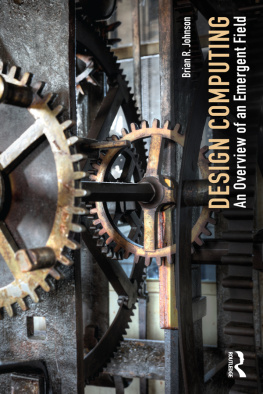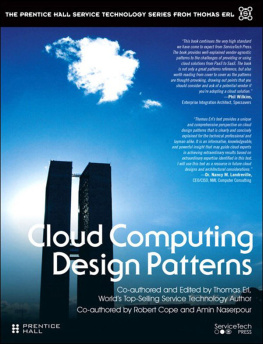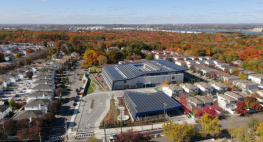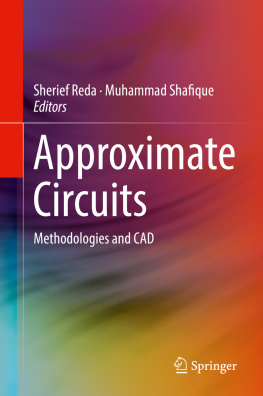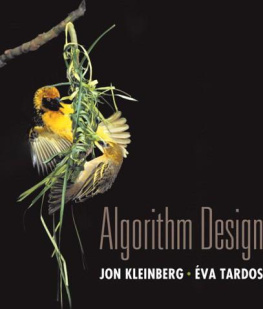Johnson - Design computing : an overview of an emergent field
Here you can read online Johnson - Design computing : an overview of an emergent field full text of the book (entire story) in english for free. Download pdf and epub, get meaning, cover and reviews about this ebook. year: 2017, publisher: Routledge, genre: Romance novel. Description of the work, (preface) as well as reviews are available. Best literature library LitArk.com created for fans of good reading and offers a wide selection of genres:
Romance novel
Science fiction
Adventure
Detective
Science
History
Home and family
Prose
Art
Politics
Computer
Non-fiction
Religion
Business
Children
Humor
Choose a favorite category and find really read worthwhile books. Enjoy immersion in the world of imagination, feel the emotions of the characters or learn something new for yourself, make an fascinating discovery.
- Book:Design computing : an overview of an emergent field
- Author:
- Publisher:Routledge
- Genre:
- Year:2017
- Rating:3 / 5
- Favourites:Add to favourites
- Your mark:
- 60
- 1
- 2
- 3
- 4
- 5
Design computing : an overview of an emergent field: summary, description and annotation
We offer to read an annotation, description, summary or preface (depends on what the author of the book "Design computing : an overview of an emergent field" wrote himself). If you haven't found the necessary information about the book — write in the comments, we will try to find it.
Design computing : an overview of an emergent field — read online for free the complete book (whole text) full work
Below is the text of the book, divided by pages. System saving the place of the last page read, allows you to conveniently read the book "Design computing : an overview of an emergent field" online for free, without having to search again every time where you left off. Put a bookmark, and you can go to the page where you finished reading at any time.
Font size:
Interval:
Bookmark:
First published 2017
by Routledge
711 Third Avenue, New York, NY 10017
and by Routledge
2 Park Square, Milton Park, Abingdon, Oxon OX14 4RN
Routledge is an imprint of the Taylor & Francis Group, an informa business
2017 Taylor & Francis
The right of Brian R. Johnson to be identified as author of this work has been asserted by him in accordance with sections 77 and 78 of the Copyright, Designs and Patents Act 1988.
All rights reserved. No part of this book may be reprinted or reproduced or utilized in any form or by any electronic, mechanical, or other means, now known or hereafter invented, including photocopying and recording, or in any information storage or retrieval system, without permission in writing from the publishers.
Trademark notice: Product or corporate names may be trademarks or registered trademarks, and are used only for identification and explanation without intent to infringe.
Library of Congress Cataloguing in Publication Data
Names: Johnson, Brian Robert, author.
Title: Design computing : an overview of an emergent field /
Brian R. Johnson.
Description: New York, NY : Routledge, 2017. | Includes bibliographical
references and index.
Identifiers: LCCN 2016020489| ISBN 9781138930964 (hb : alk. paper) |
ISBN 9781138930971 (pb : alk. paper) | ISBN 9781315680057 (ebook)
Subjects: LCSH: Building--Data processing. | Architectural design--Data
processing. | Buildings--Computer-aided design. | Architecture-
Computer-aided design.
Classification: LCC TH437 .J638 2017 | DDC 690.0285--dc23
LC record available at https://lccn.loc.gov/2016020489
ISBN: 978-1-138-93096-4 (hbk)
ISBN: 978-1-138-93097-1 (pbk)
ISBN: 978-1-315-68005-7 (ebk)
Acquisition Editor: Wendy Fuller
Editorial Assistant: Trudy Varcianna
Production Editor: Hannah Champney
Typeset in Bembo and ITC Stone Sans
by Saxon Graphics Ltd, Derby
Printed and bound by

I met Brian Johnson online. The year was 2005, and I had applied for a tenure-track teaching position at the University of Washington in Seattle. In the back-and-forth communications that are an inevitable part of academic job applications, I came to know Brian, and after the search reached its conclusion he encouraged me to join ACADIA (the Association for Computer-Aided Design in Architecture). My hunt for employment eventually took me to North Dakota State University, where from a vantage point some ten years distant, I can look back on my time in ACADIA and on conversations and collaborations with Brian over the years as critical to my understanding of the issues and questions of design computing.
But what exactly is design computing? In 2014, I invited Brian, Erin Carraher, Ning Gu, JuHyun Lee, and Wassim Jabi to join me in co-editing a special issue of Architectural Science Review on the theme of design computing (issue 58.3). As a group, we worked to define a shared understanding of the rapidly expanding content and the nebulous boundaries of the field. Its disciplinary content is characterized by a range of interests and issues which frequently overlap and cross-pollinate: simulation, visualization, and representation; humancomputer interaction, user experience, and cognition; artificial intelligence; fabrication and prototyping; parametric design and scripting; data processing and intelligent modeling; smart environments, controls, and infrastructures; algorithmic thinking; mobile, ubiquitous, and pervasive computing; and cloud computingjust to name some of the most central. Clearly, design computing, which Brian argues exists at the intersection of the built environment, design, and computing, is a content-rich field about which much has been written but which (as of yet) shows no risk of exhausting itself as a robust field of inquiry.
Its boundaries are indeed nebulous and characteristically difficult to define. At times, design computing shares formal methodologies with computer science and mathematics, seeming to succumb almost wholly to algorithmic approaches and the application of logical reasoning. However, considered at other times or looked at in different ways, design computing forcefully calls the value of logic into question: Intuition, aesthetics, and human experience all have their roles to play. To precisely delineate the boundaries of design computing is a Sisyphean task. In one sense, I see Brians book as an attempt to define the fields core values and approaches through comparison with its kindred disciplines. Often, he makes these comparisons explicit, as when he discusses traditional and digital media; but occasionally the comparisons are latent within his text and emerge only after repeated readings.
Like mathematics, design computing is concerned with patterns, whether those are patterns of thought, patterns of practice, or visual or spatial patterns. In particular, design computing is concerned with the computability of patternsthe how and why of algorithmic approaches. But unlike the rigorous discipline of pure mathematics, at its core design computing is about applicationand it is a unique kind of application which demands constant interpretation and self-critique. Brian addresses this relationship in his first chapter:
In calculus [he writes] we learn that functions have minima and maxima that can be found by differentiating the equation and solving for the derivatives zero values. Where such situations exist, that is, where a mathematical expression describes the value of a design, there is a direct mathematical, or analytic means of arriving at the best solution. We can, for example, select the best depth for a beam carrying a given load. Automating the improvement of a design is hard. There may be no clear mathematical relationship between the changes you can make to the representation and the performance metrics you wish to improve.
Thus, while design computing is abidingly concerned with the patterns and structures of computing, the questions that drive the field emerge from the needs of design. Quantifiability and computability are indeed essential tools, but there remains a dimension of design computing clearly inaccessible to automation and algorithms. Now, again like mathematics, and also like industrial or product design, the discipline of design computing seeks to identify and solve problems of a wide range and scope. But as Brian acknowledges, every problem isnt a design problem, and design doesnt require a computer. Rittel and Webbers wicked problems (Rittel and Webber 1973) hold special significance in design computing, for like acts of design, these problems are open-ended and resistant to single solutions.
Regardless of their specific discipline, designers rely on media: the material of their work. For example, architects are characterizedat least historically soby their reliance on drawings and physical models; graphic designers similarly by paper and film; and product designers by physical prototypes. Designers media are structuredthink about how they conventionally adhere to established rules of representation and the limitations of scale, or how the structure of software influences the direction and scope of inquiry. Design computing recognizes that the structure of media, whether analogue or digital, is often computable and thus inviting of algorithmic analysis. And yet again, there remains a dimension to the field which is not obviously susceptible to a pure-mathematics approach. Brian notes how the fluidity of interaction and range of expression made possible by pen and paper is substantially challenging to register through digital tools. With this comment and in his subsequent discussion, he suggests that design computingperhaps more so than other design disciplinesacknowledges that media and representations are not neutral with respect to their application or their outcomes.
Font size:
Interval:
Bookmark:
Similar books «Design computing : an overview of an emergent field»
Look at similar books to Design computing : an overview of an emergent field. We have selected literature similar in name and meaning in the hope of providing readers with more options to find new, interesting, not yet read works.
Discussion, reviews of the book Design computing : an overview of an emergent field and just readers' own opinions. Leave your comments, write what you think about the work, its meaning or the main characters. Specify what exactly you liked and what you didn't like, and why you think so.

